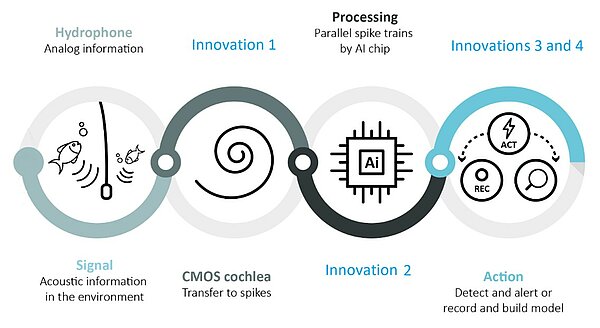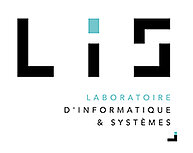Objectifs
The objective is to design a bioinspired CMOS cochlea able (like any mammal ear) to convert acoustic analog signals to parallel trains of spikes and bi (multi-channel) naurally to localization. The cochlea will be connected to an existing ULP hydrophone to listen and localize acoustic events with high accuracy. (Innovation 1).
KPI n°1: Expected achievement: a ULP artificial cochlea (1 kHz to 100 kHz at least) which mimics biology with an ultra-low power energy consumption of 10 milliwatts (a hundred times better than current technology).
“AI chip” refers to the new generation of microprocessors which are specifically designed to mimic the brain to process artificial intelligence tasks faster, using spectacularly less power and off the cloud. We are going to develop the first bioinspired and binaural audio processor using spiking neural networks (SNNs) whose power consumption would be between 1 and 10 milliwatts. (Innovation 2).
KPI n°2: an SNN on chip that can run any Spiking Neural Network which learns and classifies a broad scope of natural data, in particular acoustic signals, even in a noisy environment.
The rapid increase in ambient noise from human activities has led scientists to question the impacts of noise pollution on marine ecosystems. The first alerts appeared with the mass stranding of beaked whales in parallel with the massive use of devices emitting sound waves of strong powers (military sonars in particular). Our acoustic sensor can be well-tuned to detect very specific events of interest, to produce "alerts" with some associated spatial info. It can detect vulnerable species like cetaceans and alert around, for instance, oil-gas exploration ships. From the opposite perspective, it can detect fishermen boats, touristic boats, illegal fishing with explosives that may interfere with fish communication and endanger them. (Innovation 3).
KPI n°3: alert sensors tuned (from 1 kHz to 100 kHz) to detect in real-time specific sounds or noises to act at a large scale for the animal welfare, to protect under intrusion natural parks and reserves, to establish fishing and navigation rules to protect the environment.
The monitoring program associated to the development of innovative bioinspired acoustic sensing and processing technologies will give us an overview of the marine soundscapes of the central Mediterranean Sea and an image of their composition in terms of biological sources vs anthropogenic noise sources. Our knowledge gaps are related to the difficulties in monitoring long term effects, and understanding their biological meaning. Animal responses can be modified by habituation, anthus underestimated; however, habituation is not a solution to the noise problem; we need to further develop our understanding of the long term, cumulative and synergistic effects of noise pollution. (Innovation 4).
KPI n°4: An autonomous learning sensor which can listen, classify with high accuracy by itself off the cloud various sources of sound or noise (known or unknown), builds a sound map to measure biodiversity and the quality of the acoustic environment in which marine life develops and its evolution for a long time.




